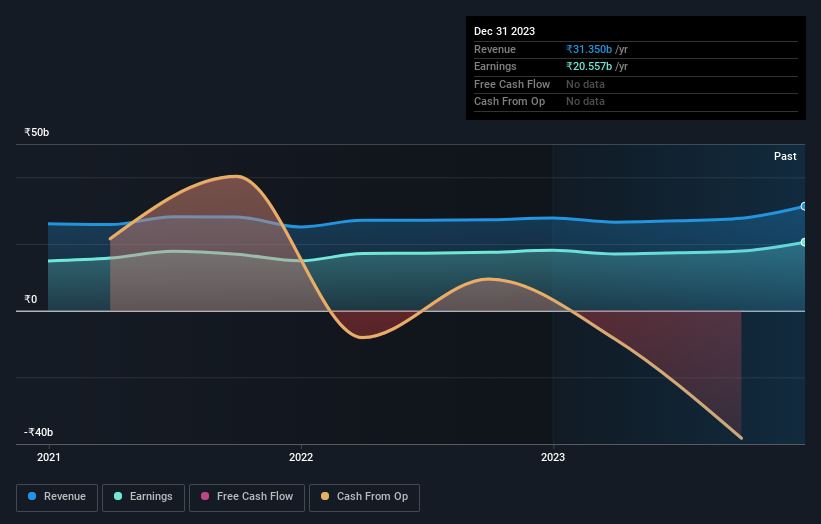Stock Analysis
- India
- /
- Diversified Financial
- /
- NSEI:HUDCO
State or government who hold 75% of Housing and Urban Development Corporation Limited (NSE:HUDCO) gained 17%, institutions profited as well

Key Insights
- The considerable ownership by state or government in Housing and Urban Development indicates that they collectively have a greater say in management and business strategy
- 54% of the company is held by a single shareholder (India)
- Institutional ownership in Housing and Urban Development is 13%
To get a sense of who is truly in control of Housing and Urban Development Corporation Limited (NSE:HUDCO), it is important to understand the ownership structure of the business. And the group that holds the biggest piece of the pie are state or government with 75% ownership. Put another way, the group faces the maximum upside potential (or downside risk).
While state or government were the group that reaped the most benefits after last week’s 17% price gain, institutions also received a 13% cut.
Let's delve deeper into each type of owner of Housing and Urban Development, beginning with the chart below.
View our latest analysis for Housing and Urban Development

What Does The Institutional Ownership Tell Us About Housing and Urban Development?
Institutions typically measure themselves against a benchmark when reporting to their own investors, so they often become more enthusiastic about a stock once it's included in a major index. We would expect most companies to have some institutions on the register, especially if they are growing.
As you can see, institutional investors have a fair amount of stake in Housing and Urban Development. This suggests some credibility amongst professional investors. But we can't rely on that fact alone since institutions make bad investments sometimes, just like everyone does. When multiple institutions own a stock, there's always a risk that they are in a 'crowded trade'. When such a trade goes wrong, multiple parties may compete to sell stock fast. This risk is higher in a company without a history of growth. You can see Housing and Urban Development's historic earnings and revenue below, but keep in mind there's always more to the story.

Hedge funds don't have many shares in Housing and Urban Development. Looking at our data, we can see that the largest shareholder is India with 54% of shares outstanding. This essentially means that they have extensive influence, if not outright control, over the future of the corporation. With 21% and 8.9% of the shares outstanding respectively, Ministry of Rural Development and Life Insurance Corporation of India, Asset Management Arm are the second and third largest shareholders.
Researching institutional ownership is a good way to gauge and filter a stock's expected performance. The same can be achieved by studying analyst sentiments. Our information suggests that there isn't any analyst coverage of the stock, so it is probably little known.
Insider Ownership Of Housing and Urban Development
While the precise definition of an insider can be subjective, almost everyone considers board members to be insiders. Company management run the business, but the CEO will answer to the board, even if he or she is a member of it.
Most consider insider ownership a positive because it can indicate the board is well aligned with other shareholders. However, on some occasions too much power is concentrated within this group.
We note our data does not show any board members holding shares, personally. It is unusual not to have at least some personal holdings by board members, so our data might be flawed. A good next step would be to check how much the CEO is paid.
General Public Ownership
With a 12% ownership, the general public, mostly comprising of individual investors, have some degree of sway over Housing and Urban Development. This size of ownership, while considerable, may not be enough to change company policy if the decision is not in sync with other large shareholders.
Next Steps:
It's always worth thinking about the different groups who own shares in a company. But to understand Housing and Urban Development better, we need to consider many other factors. Consider for instance, the ever-present spectre of investment risk. We've identified 3 warning signs with Housing and Urban Development (at least 2 which are concerning) , and understanding them should be part of your investment process.
If you would prefer check out another company -- one with potentially superior financials -- then do not miss this free list of interesting companies, backed by strong financial data.
NB: Figures in this article are calculated using data from the last twelve months, which refer to the 12-month period ending on the last date of the month the financial statement is dated. This may not be consistent with full year annual report figures.
Valuation is complex, but we're helping make it simple.
Find out whether Housing and Urban Development is potentially over or undervalued by checking out our comprehensive analysis, which includes fair value estimates, risks and warnings, dividends, insider transactions and financial health.
View the Free AnalysisHave feedback on this article? Concerned about the content? Get in touch with us directly. Alternatively, email editorial-team (at) simplywallst.com.
This article by Simply Wall St is general in nature. We provide commentary based on historical data and analyst forecasts only using an unbiased methodology and our articles are not intended to be financial advice. It does not constitute a recommendation to buy or sell any stock, and does not take account of your objectives, or your financial situation. We aim to bring you long-term focused analysis driven by fundamental data. Note that our analysis may not factor in the latest price-sensitive company announcements or qualitative material. Simply Wall St has no position in any stocks mentioned.
About NSEI:HUDCO
Housing and Urban Development
Housing and Urban Development Corporation Limited provides loans for housing and infrastructure development projects in India.
Proven track record with mediocre balance sheet.

